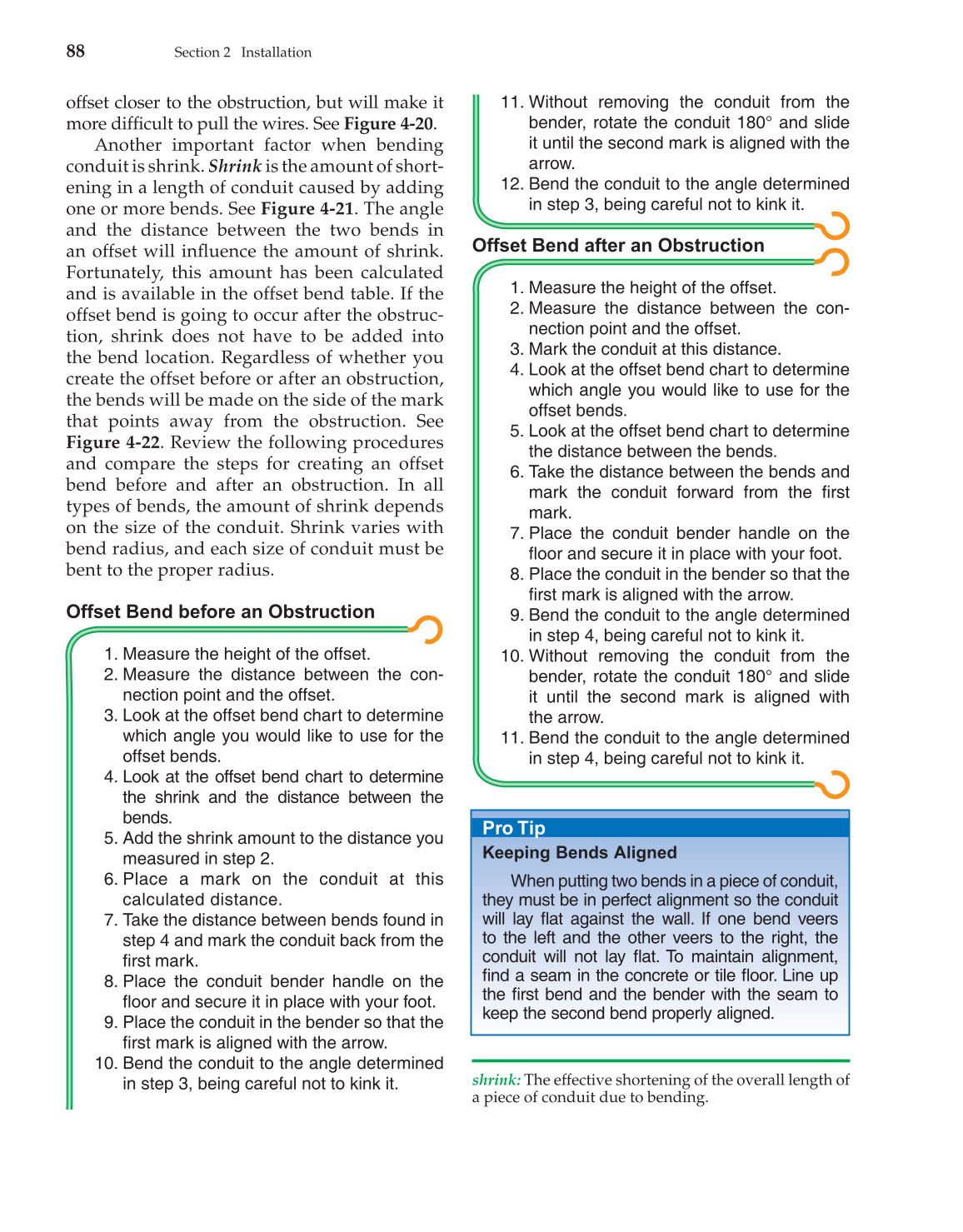88
Section 2 Installation
offset closer to the obstruction, but will make it
more diffi cult to pull the wires. See Figure 4-20.
Another important factor when bending
conduit is shrink. Shrink is the amount of short-
ening in a length of conduit caused by adding
one or more bends. See Figure 4-21. The angle
and the distance between the two bends in
an offset will infl uence the amount of shrink.
Fortunately, this amount has been calculated
and is available in the offset bend table. If the
offset bend is going to occur after the obstruc-
tion, shrink does not have to be added into
the bend location. Regardless of whether you
create the offset before or after an obstruction,
the bends will be made on the side of the mark
that points away from the obstruction. See
Figure 4-22. Review the following procedures
and compare the steps for creating an offset
bend before and after an obstruction. In all
types of bends, the amount of shrink depends
on the size of the conduit. Shrink varies with
bend radius, and each size of conduit must be
bent to the proper radius.
Offset Bend before an Obstruction
1. Measure the height of the offset.
2. Measure the distance between the con-
nection point and the offset.
3. Look at the offset bend chart to determine
which angle you would like to use for the
offset bends.
4. Look at the offset bend chart to determine
the shrink and the distance between the
bends.
5. Add the shrink amount to the distance you
measured in step 2.
6. Place a mark on the conduit at this
calculated distance.
7. Take the distance between bends found in
step 4 and mark the conduit back from the
fi rst mark.
8. Place the conduit bender handle on the
fl oor and secure it in place with your foot.
9. Place the conduit in the bender so that the
fi rst mark is aligned with the arrow.
10. Bend the conduit to the angle determined
in step 3, being careful not to kink it.
11. Without removing the conduit from the
bender, rotate the conduit 180° and slide
it until the second mark is aligned with the
arrow.
12. Bend the conduit to the angle determined
in step 3, being careful not to kink it.
Offset Bend after an Obstruction
1. Measure the height of the offset.
2. Measure the distance between the con-
nection point and the offset.
3. Mark the conduit at this distance.
4. Look at the offset bend chart to determine
which angle you would like to use for the
offset bends.
5. Look at the offset bend chart to determine
the distance between the bends.
6. Take the distance between the bends and
mark the conduit forward from the fi rst
mark.
7. Place the conduit bender handle on the
fl oor and secure it in place with your foot.
8. Place the conduit in the bender so that the
fi rst mark is aligned with the arrow.
9. Bend the conduit to the angle determined
in step 4, being careful not to kink it.
10. Without removing the conduit from the
bender, rotate the conduit 180° and slide
it until the second mark is aligned with
the arrow.
11. Bend the conduit to the angle determined
in step 4, being careful not to kink it.
Pro Tip
Keeping Bends Aligned
When putting two bends in a piece of conduit,
they must be in perfect alignment so the conduit
will lay fl at against the wall. If one bend veers
to the left and the other veers to the right, the
conduit will not lay fl at. To maintain alignment,
fi nd a seam in the concrete or tile fl oor. Line up
the fi rst bend and the bender with the seam to
keep the second bend properly aligned.
shrink: The effective shortening of the overall length of
a piece of conduit due to bending.
